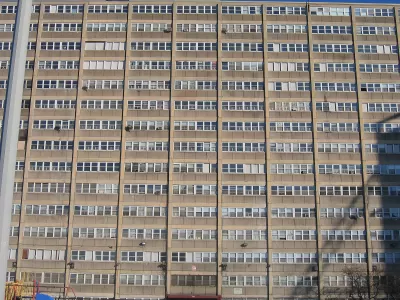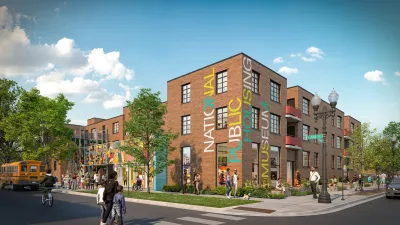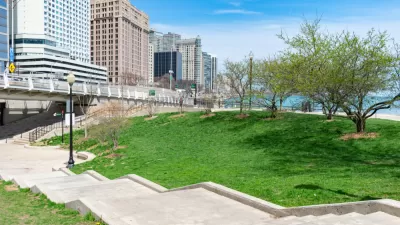The new film, set in one of America's most notorious public housing projects, highlights the failure of affordable housing policy and its impact on Black communities.

Like its 1992 predecessor, the Jordan Peele-produced Candyman places Cabrini-Green at the center of its story, making the real-life demise of the complex "the fundamental origin story of the film’s vengeful spirit." Brentin Mock describes the history and trauma that informs the film, which blends supernatural terror with extremely real horrors of neglected public housing projects and bad housing policy.
While the slasher in the film–"the apparition of a former Cabrini-Green resident who was killed by police in the 1970s"–is very real, writes Mock, gentrification is "the force that conjured it." Cabrini-Green's mostly Black residents "could live in few other neighborhoods in Chicago, due to racial covenants, job discrimination and lack of income." At the same time, "it was mostly Black people there who were first frozen out of their homes, due to the city’s withdrawal of services, and then driven out when the city decided Cabrini-Green had become too much of a blight" and had to be demolished. Today, the destruction of Cabrini-Green is "considered one of the largest losses of affordable housing stock in U.S. history."
This cruel paradox is explained with brevity in the film by Teyonah Parris's character, Brianna: "White people built the ghetto and then erased it when they realized they built the ghetto." Candyman, who shows up in mirrors when summoned, "is a reflection of destruction that white people have long visited upon Black people," says Mock, and the lingering problems that they are afraid to name.
FULL STORY: In Slasher Film ‘Candyman,’ the Horror Is U.S. Housing Policy

Study: Maui’s Plan to Convert Vacation Rentals to Long-Term Housing Could Cause Nearly $1 Billion Economic Loss
The plan would reduce visitor accommodation by 25,% resulting in 1,900 jobs lost.

North Texas Transit Leaders Tout Benefits of TOD for Growing Region
At a summit focused on transit-oriented development, policymakers discussed how North Texas’ expanded light rail system can serve as a tool for economic growth.

Using Old Oil and Gas Wells for Green Energy Storage
Penn State researchers have found that repurposing abandoned oil and gas wells for geothermal-assisted compressed-air energy storage can boost efficiency, reduce environmental risks, and support clean energy and job transitions.

Santa Barbara Could Build Housing on County Land
County supervisors moved forward a proposal to build workforce housing on two county-owned parcels.

San Mateo Formally Opposes Freeway Project
The city council will send a letter to Caltrans urging the agency to reconsider a plan to expand the 101 through the city of San Mateo.

A Bronx Community Fights to Have its Voice Heard
After organizing and giving input for decades, the community around the Kingsbridge Armory might actually see it redeveloped — and they want to continue to have a say in how it goes.
Urban Design for Planners 1: Software Tools
This six-course series explores essential urban design concepts using open source software and equips planners with the tools they need to participate fully in the urban design process.
Planning for Universal Design
Learn the tools for implementing Universal Design in planning regulations.
Ascent Environmental
Borough of Carlisle
Institute for Housing and Urban Development Studies (IHS)
City of Grandview
Harvard GSD Executive Education
Toledo-Lucas County Plan Commissions
Salt Lake City
NYU Wagner Graduate School of Public Service




























